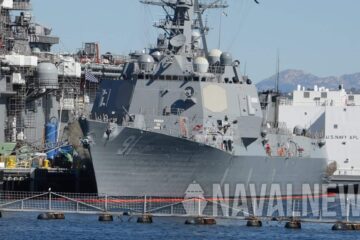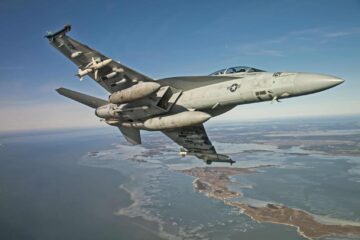The Admiral explains what PACFLEET is, its area of responsibility, its assets… Admiral Paparo also discusses the challenges that the Pacific Fleet face in the INDOPACOM region and names some of the key partners in the region (such as France, Japan, South Korea, the Philippines, Australia…). Paparo ends by explaining why large scale combined exercises are important.
The interview was recorded during the Indo-Pacific 2022 trade show in Sydney, Australia, in May 2022.

Xavier Vavasseur, Naval News: So can you please first tell us what is PACFLEET?
Admiral Sam Paparo: Yeah, thank you. U.S. Pacific Fleet is the maritime component of the United States Navy for the Pacific and most of the Indian Oceans. Our responsibilities span for all Navy forces from essentially the Mississippi River to the to the India Pakistan border, as we say, from Hollywood to Bollywood and from polar bears to penguins is the area of responsibility for the United States Pacific Fleet. We are also the joint force maritime Component Command of U.S. Indo Pacific Command, the unified combatant command, who is in charge in charge of all U.S. operations throughout the Indo Pacific Area of Responsibility.
Xavier Vavasseur: How many ships are under your command and how many sailors?
Admiral Sam Paparo: it is 200 ships, 160,000 sailors. 1,500 aircraft are all a part of the U.S. Pacific Fleet, approximately 60% of the United States Navy.
Xavier Vavasseur: Wow, and that alone is larger than most navies around the world…
Admiral Sam Paparo: It is! It’s an honor to lead the U.S. Pacific Fleet. It was the iconic command led by Admiral Chester W Nimitz in the in the Second World War. And it’s a tremendous responsibility and a tremendous honor. The United States is a maritime nation. And accordingly, we have a scaled force that meets the responsibility of a nation with great maritime responsibilities.
Xavier Vavasseur: So Admiral, what kind of challenges does PACFLEET face today in the region?
Admiral Sam Paparo: It is a highly contested region with four of the five key threats to the liberal rules based order that the world enjoys at this time. This includes:
- the People’s Republic of China,
- Russia,
- it includes North Korea
- and violent extremist groups.
And so all of these nations in one way or the other, frequently seek to upend or to bend the international rules based order, which is very important to the security and the well being of all of our nations. And these challenge manifests itself in matters small and large in ways that violate sovereignty, that violate conventions such as the United Nations Convention on the Law of the Sea, who encroach, who attempt to coerce all of our neighbors and allies throughout the Pacific. This is a key challenge. And it’s important to be operating dynamically and most of all, in partnership, to demonstrate to those that would upend the rules based order by force that today is not the day to do so, that there is a robust force that’s ready in deterrence, and along the way, to demonstrate the legitimacy of the rules based order through allied and partnered operations. Because the thing that those actors abour the most is the solidarity of the nations that support the order.
Xavier Vavasseur: You just mentioned the importance of allies. So who are your key partners in the region?
Admiral Sam Paparo: Well, given the media outlet, I’d be remiss to leave out France as an absolute key partner. Obviously, France is also the United States oldest ally, as you know, our very first ally, and France has a wide and important and vibrant geography in the South Pacific. And so my partner at Admiral Jean-Mathieu Rey is the ALPACI commander* and is a absolute key partner. But other partners include Japan, Philippines, Korea, Australia, obviously, we’re here, Australia, New Zealand, but I’d be hard pressed to tell you which nation isn’t a partner in one manner or another in the Indo-Pacific and you can see that here at this conference.
*RADM Geoffroy d’Andigné replaced RADM Jean-Mathieu Rey as Joint Commander of the French Armed Forces in the Asia-Pacific (ALPACI) on August 1st, 2022.
Xavier Vavasseur: I cannot help but notice, in the past couple years, there has been a lot of combined exercises in large scale, involving lots of big deck Amphibs or flattops, or large surface ships formations. How is this important?
Admiral Sam Paparo: I think that this is important to demonstrate the fires and effects that can be brought to bear rapidly to anyone that try to to to effect a rapid strike on one of our partners to upend the order. To see how quickly, how easily these large forces, employing very capable high end ships, employing very high end sensors, very high end weapons, can aggregate, can integrate under single commanders, can operate on a common operating picture and can act in unison when the Coalition of the Willing decides and I think that that demonstration has a key deterrent effect on those that would upend in the order.





